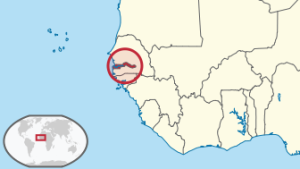[:de]Gambia liegt an der äussersten Westküste und ist der kleinste Staat in Afrika. Er ist auf drei Seiten vom Senegal umgeben und stösst im Westen an den Atlantik. Mitten durch das langgestreckte Land fliesst der Gambiafluss, welcher im Bergland des Futa-Djallons in Guinéa entspringt und in Gambia in den Atlantik mündet.
Gambia ist abgesehen von einer florierenden Tourismusindustrie immer noch eines der ärmsten Länder der Welt. Obwohl Gambia seit seiner Unabhängigkeit politisch stabil ist, hat diese Stabilität für die meisten Gambier nicht zu einer Steigerung ihres Wohlstandes geführt. Gambia gehört in die Reihe derjenigen Länder, deren Bevölkerung heute ärmer ist als noch vor 30 Jahren.
Drei Viertel aller Gambierinnen und Gambier leben von der Landwirtschaft, welche vor allem durch den Anbau von Erdnüssen und Hirse geprägt ist. Nur ein Sechstel des Landes ist fruchtbar. Das UN World Food Programme hat beobachtet, dass neben dieser knappen ökonomischen Basis auch Faktoren wie eine schwache Marktwirtschaft oder das Fehlen von Wissen sowie Technologien den landwirtschaftlichen Sektor zusätzlich schwächen.
60% der Bevölkerung Gambias sind Jugendliche unter 25 Jahren, mit wenig bis gar keinem Zugang zu Bildung oder Berufslehren und somit auch wenig Aussicht auf Einkommen (Quelle: CIA-Worldfactbook). Die Regierung hat den Bedarf an Ausbildungsplätzen bereits seit langem erkannt: Die seit 1997 geltende Verfassung von Gambia sowie der Bildungsartikel von 1963 enthalten spezifische Angaben zur Bereitstellung von Ausbildungsmöglichkeiten für Jugendliche. Andere, in dieselbe Richtung weisende Dokumente sind unter anderem die Strategie zur Reduktion der Armut von 2002 und der Bericht zur Vision der Regierung bis 2020. Letzterer spricht unter anderem davon «credit, finance, technology, improvements in education, skills training and institutional support services» bereitzustellen, um den Jugendlichen beim Ausstieg aus der Armutsfalle durch die Schaffung von Arbeitsplätzen zu helfen.
Eine besondere Herausforderung für das Berufsbildungssystem in Gambia stellt das niedrige Niveau der Schulabgänger dar. Da in der Primarstufe nur wenige Schülerinnen und Schüler die geforderten Standards in Englisch oder Mathematik erreichen, sehen sich viele beim Eintritt in die Sekundarstufe enormen Schwierigkeiten gegenüber. Als Folge davon tritt eine grosse Anzahl der Schülerinnen und Schüler regulär oder irregulär nach der Primarstufe aus der Schule aus und steigt mit einem tiefen Bildungsstand in den Arbeitsmarkt ein, wo sie nur geringe Aussichten auf eine Stelle haben (Quelle: UNESCO). Da die Regierung dieses Dilemma nicht gelöst hat, ist sie bis heute nicht in der Lage, genügend einheimische Fachkräfte auszubilden. Bezeichnend ist denn auch der Umstand, dass der grösste Teil der Fachkräfte in Gambia aus dem benachbarten Ausland stammt.
[:en]
The Gambia is located on the Atlantic coast of Africa, and is the smallest country on the continent, surrounded on three side by Senegal. The River Gambia springs from the Highlands of Fouta Djallon and runs right through the Gambias long, narrow strip of land before flowing into the ocean at the west coast.
Not counting its flourishing tourist trade, The Gambia is one of the poorest countries in the world. The political stability that the country enjoys through its independence, has not meant a rise in living standards for most Gambians. The Gambia is one of the countries of the world that is poorer today than it was 30 years ago.
Three quarters of all Gambians are farmers, and mostly grow millet and peanuts, but only one sixth of the land is fertile. The UN World Food Programme has found that these difficult conditions are made worse by The Gambia’s weak market economy and lack of technological know-how, leading to a very weak agriculture industry.
60% of The Gambia’s population are under 25 years old, with little, or no, access to education or training, and as a result with little chance to getting an income (Source: CIA-World Factbook). The need for more training positions has long been known by the government. The Gambia’s constitution, that has been in place since 1997, as well as its education Act from 1963 contain specific details about providing training and education for young people. Other documents in a similar line can be found under Strategy for Poverty Alleviation and this article about the government’s “Vision 2020” strategy. The latter discusses making “credit, finance, technology, improvements in education, skills, training and institutional support services,” available to young people to create new jobs, which should help them out of the poverty trap.
The high number of early school leavers is a particular challenge for the vocational and professional training system in The Gambia. As few children reach the required standards for English or maths in primary school, many have great problems when they get to higher levels. As a result a large number of young people drop out of school, enter the job market with a low level of education and in so doing have low chances of finding a job (Source: UNESCO).
As the government has not been able to resolve this problem, it is still not in the position to train enough skilled workers locally: For the most part skilled workers come from neighbouring countries.
[:]

